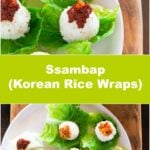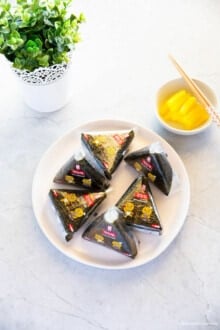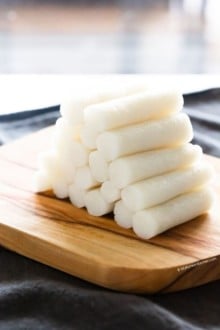Easy Ssambap recipe!
Are you familiar with ssam? Ssam (쌈) means any wrapped food in edible leaves and edible seaweed. If you have tried Korean BBQ meat in some lettuce leaves, that is called ssam as well.
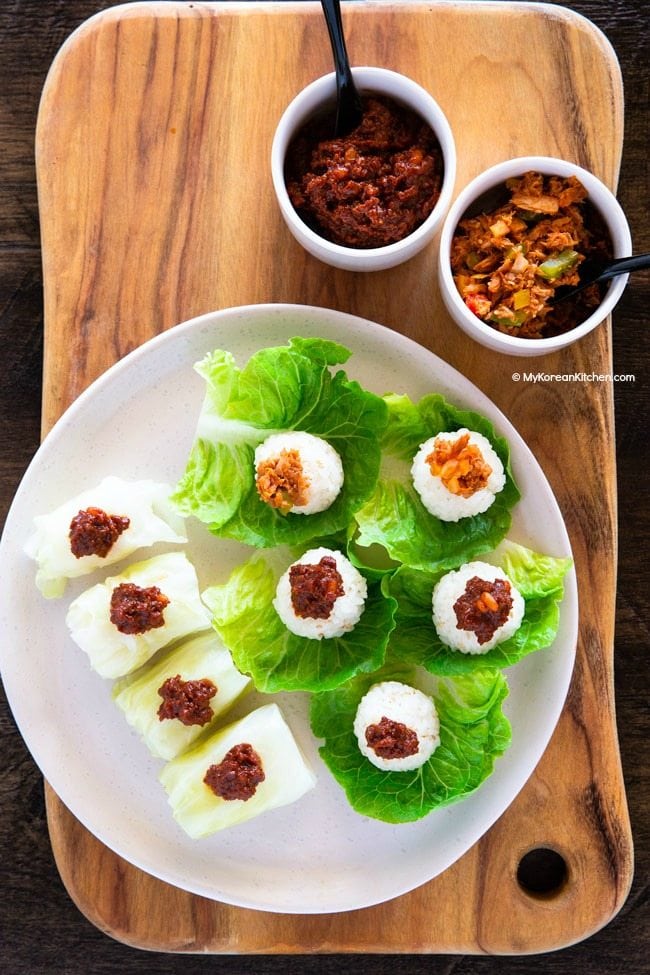
One type of ssam I love is Ssambap (쌈밥).
What is Ssambap
Essentially, ssambap means rice wrapped in leaves. These leaves can be any edible leaves that are fresh or lightly steamed, and also that are large enough to wrap rice and condiments.
Popular leaves include lettuce, Korean perilla leaves, squash leaves, kale leaves, bok choy leaves, cabbage leaves, and napa cabbage leaves.
However, some people also use edible seaweeds such as brown seaweed (미역) and kelp / kombu (다시마) as a wrapper too.
Why is Ssambap Popular
Ssambap is a popular Korean rice dish. I don’t know why but us Koreans love wrapping rice (or anything edible) in green leafy vegetables! LOL
Ssambap can be eaten all year round, but the most popular time is during spring and summer as there are more fresh vegetables to accompany it.
Also, ssambap is known as a healthy diet meal, particularly when it is served with cabbage leaves. Because it makes you feel fuller sooner and longer, so you don’t feel the need to eat as much.
There are also many Korean restaurants specializing in Ssambap too.
They will often have a menu called “Ssambap Jeongsik” (쌈밥정식), which includes various leaves with various dipping sauces, several side dishes, soup or stew and some stir fried meat.
It’s quite filling and delicious! My mouth is watering just writing about it. 😉
How to Serve Ssambap
In its simplest form, you can serve ssambap with some steamed rice, green leafy vegetables and a dipping sauce (known as ssamjang).
To make it fancier, you can season the steamed rice with some salt, sesame oil and sesame seeds as well. (Which is what I did in this recipe.)
FYI, some even more fancier rice is mixed with seasoned dried anchovies or cooked minced beef as well. The sky is the limit!
Also, you can make the whole ssambap experience DIY or serve / decorate as shown in the picture above, which is more work for the cook/host. What’s more appealing to you?
Finally, as I mentioned previously, there are some great companion dishes to serve with ssambap if you choose to go this path. Below are some of my suggestions. 🙂
Meat
- Jeyuk Bokkeum (Korean spicy pork stir fry)
- Bulgogi (Korean BBQ beef stir fry)
Soup / Stew
- Doenjang Jjigae (Korean soybean paste stew)
- Kimchi Jjigae (Kimchi stew)
Side dishes
- Musaengchae (Shredded radish kimchi)
- Eomuk Bokkeum (Korean fish cake side dish)
- Yeon-geun Jorim (Korean braised lotus root)
- Sukju Namul Muchim (Seasoned bean sprout salad)
Last Tips
I think the key point of making delicious ssambap is making delicious ssamjang (쌈장), the dipping sauce.
Because, if you have delicious sauce, you don’t really need any extra side dishes to enjoy your meal. Rice, leaves and the dipping sauce is all you need! Trust me!
Ingredients for Ssambap
Rice and Rice seasoning – Makes about 14 rice balls
- 2 cups steamed short grain rice (sushi rice)
- fine sea salt, to taste
- 1/2 tsp sesame oil
- 1 tsp toasted sesame seeds
Wrapper Options
- lettuce (e.g. baby cos, buttercup etc)
- perilla leaves
- kale leaves
- bok choy leaves
- green cabbage
- napa cabbage (yellow leaves, inner part of the cabbage are suitable)
Ssamjang Options
- Yak Gochujang (Stir fried gochujang sauce with beef)
- Chamchi Ssamjang (Korean spicy tuna sauce)
* 1 Tbsp = 15 ml, 1 Cup = 250 ml
** If you want to learn more about Korean ingredients, check my essential Korean ingredients list!
How to Make Ssambap
1. If you’re using fresh green leaves, rinse them well in running water and drain the water well. Depending how you serve, you may want to cut the stem off, so they fold better.
If you’re using leaves that are a bit stiff (e.g. cabbage leaves), you may want to steam them first. Here’s how to steam the cabbage.
- Peel and remove any tough / damaged outer layers of cabbage leaves.
- Cut the cabbage into quarters (from a whole cabbage).
- Cut off the core of the cabbage leaves and cut the cabbage wedge length way to further remove the hard stems.
- Separate the cabbage leaves from the head.
- Rinse the cabbage leaves under running water.
- Boil some water in a steamer pot over medium high heat. Once the water is rolling boiling, add the cabbage leaves into the steamer. Steam the leaves until the leaves are soft, about 10 mins.
- Remove the steamer from the heat and cool the leaves down for about 5 mins (or until safe to touch) then gently shake off any residue water from the leaves.

2. Combine the rice and rice seasoning ingredients in a mixing bowl. Mix them well. If serving ssambap pre-assembled, scoop out some seasoned rice and make it into a bite sized ball.
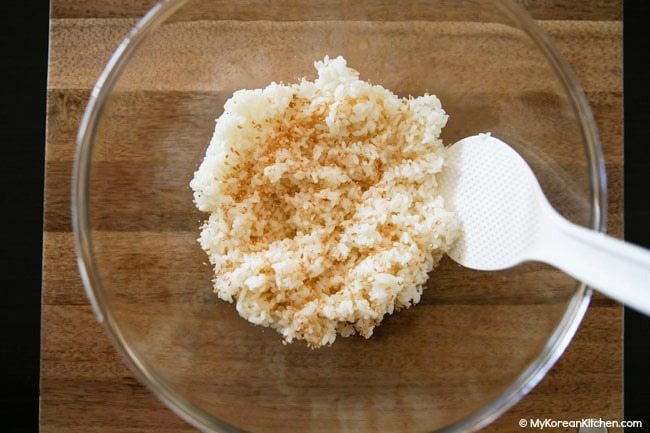
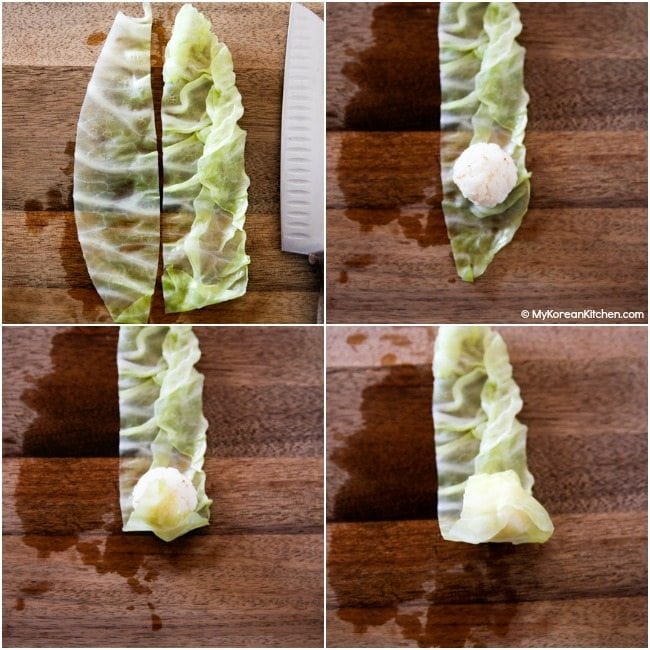
3. Serve the ball of rice on a leaf, then top with ssamjang sauce. (You can place the sauce inside of the wrap or outside of the wrap depending how you roll/wrap/serve.)
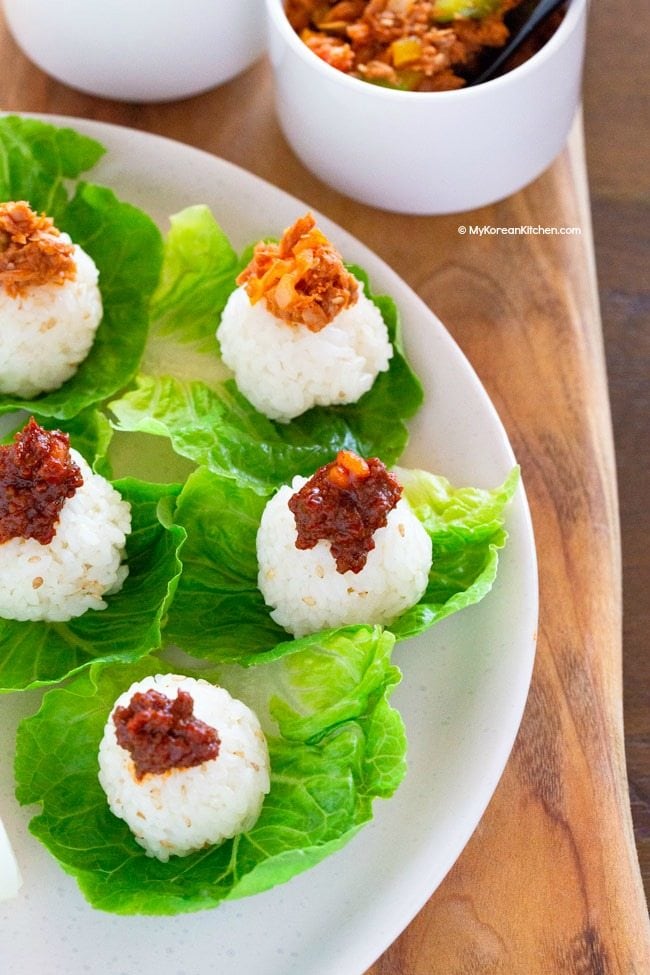
Make Ahead Tips
- To save time, you can prepare the leafy vegetables, rice and the sauce components all at different times. You can easily store pre-rinsed & spun dried leafy vegetables in a container in the fridge for a few days. Also, the dipping sauce, depending on what you’re making, can last for a few days to up to one month.
- The rice can be served warm or at room temperature (per your preference), so you can plan it accordingly.

Ssambap (Korean Rice Lettuce Wraps)
Ingredients
RICE AND RICE SEASONING
- 2 cups steamed short grain rice (sushi rice)
- fine sea salt , to taste
- 1/2 tsp sesame oil
- 1 tsp toasted sesame seeds
WRAPPER OPTIONS
- lettuces
- perilla leaves
- kale leaves
- bok choy leaves
- green cabbage
- napa cabbage (yellow leaves, inner part of the cabbage are suitable)
SSAMJANG OPTIONS
- Yak Gochujang (Stir fried gochujang sauce with beef)
- Chamchi Ssamjang (Korean spicy tuna)
Instructions
- If you’re using fresh green leaves, rinse them well in running water and drain the water well. Depending how you serve, you may want to cut the stem off, so they fold better.If you’re using leaves that are a bit stiff (e.g. cabbage leaves), you may want to steam them first. Here’s how to steam the cabbage.-Peel and remove any tough / damaged outer layers of cabbage leaves.-Cut the cabbage into quarters (from a whole cabbage).-Cut off the core of the cabbage leaves and cut the cabbage wedge length way to further remove the hard stems.-Separate the cabbage leaves from the head.-Rinse the cabbage leaves under running water.-Boil some water in a steamer pot over medium high heat. Once the water is rolling boiling, add the cabbage leaves into the steamer. Steam the leaves until the leaves are soft, about 10 mins.-Remove the steamer from the heat and cool the leaves down for about 5 mins (or until safe to touch) then gently shake of any residue water from the leaves.
- Combine the rice and rice seasoning ingredients in a mixing bowl. Mix them well. If serving ssambap pre-assembled, scoop out some seasoned rice and make it into a bite sized ball.
- Serve the ball of rice on a leaf then top with ssamjang sauce. (You can place the sauce inside of the wrap or outside of the wrap depending how you roll/wrap/serve.)
Nutrition Info (per serving)
The nutrition information shown is an estimate provided by an online nutrition calculator. It should not be considered a substitute for a professional nutritionist’s advice.
